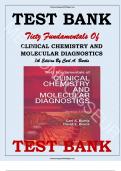Ultimatestudyguide2021@gmail.com
TEST BANK
M
Tietz Fundamentals Of
ED
CLINICAL CHEMISTRY AND
MOLECULAR DIAGNOSTICS
C
7th Edition By Carl A. Burtis
O
N
N
O
IS
SE
U
R
TEST BANK Ultimatestudyguide2021@gmail.com
, Tietz Fundamentals of Clinical Chemistry and Molecular Diagnostics 7th Edition Test Bank
Table of contents:
I. Principles Of Laboratory Medicine
Chapter 1. Clinical Chemistry, Molecular Diagnostics, and Laboratory Medicine
M
Chapter 2. Selection and Analytical Evaluation of Methods — With Statistical Techniques
Chapter 3. Clinical Evaluation of Methods
Chapter 4. Evidence-Based Laboratory Medicine
ED
Chapter 5. Establishment and Use of Reference Values
Chapter 6. Specimen Collection, Processing, and Other Preanalytical Variables
Chapter 7. Quality Management
II. Analytical Techniques And Instrumentation
Chapter 8. Principles of Basic Techniques and Laboratory Safety
C
Chapter 9. Optical Techniques
Chapter 10. Electrochemistry and Chemical Sensors
O
Chapter 11. Electrophoresis
Chapter 12. Chromatography
Chapter 13. Mass Spectrometry
N
Chapter 14. Enzyme and Rate Analyses
Chapter 15. Immunochemical Techniques
Chapter 16 Automation
N
Chapter 17. Point-of-Care Instrumentation
III. Analytes
O
Chapter 18. Amino Acids, Peptides, and Proteins
Chapter 19. Serum Enzymes
Chapter 20. Tumor Markers and Cancer Genes
IS
Chapter 21. Kidney Function Tests — Creatinine, GFR, Urea, and Uric Acid
Chapter 22. Carbohydrates
Chapter 23. Lipids, Lipoproteins, Apolipoproteins, and Other Cardiac Risk Factors
SE
Chapter 24. Electrolytes and Blood Gases
Chapter 25. Hormones
Chapter 26. Catecholamines and Serotonin
Chapter 27. Vitamins, Trace Elements, Nutritional Assessment
Chapter 28. Hemoglobin, Iron, and Bilirubin
U
Chapter 29. Porphyrins and Porphyrias
Chapter 30. Therapeutic Drugs and Their Management
R
Chapter 31. Clinical Toxicology
Chapter 32. Toxic Metals
IV. Pathophysiology
Chapter 33. Diabetes
, Chapter 34. Cardiovascular Disease
Chapter 35. Kidney Disease
Chapter 36. Physiology and Disorders of Water, Electrolyte, and Acid-Base Metabolism
Chapter 37. Liver Disease
Chapter 38. Gastrointestinal and Pancreatic Diseases
M
Chapter 39. Disorders of Bone and Mineral Metabolism
Chapter 40. Disorders of the Pituitary Gland
Chapter 41. Disorders of the Adrenal Cortex
ED
Chapter 42. Thyroid Disorders
Chapter 43. Reproduction-Related Disorders
Chapter 44. Pregnancy and Prenatal Testing
Chapter 45. Newborn Screening and Inborn Errors of Metabolism
C
Chapter 46. Pharmacogenetics
V. Molecular Diagnostics
Chapter 47. Principles of Molecular Biology
O
Chapter 48. Nucleic Acid Techniques and Applications
Chapter 49. Genomes and Nucleic Acid Alterations
N
N
O
IS
SE
U
R
Ultimatestudyguide2021@gmail.com
, Tietz Fundamentals of Clinical Chemistry and MolecularDiagnostics, 7e Burtis Test Bank
Chapter 01: Clinical Chemistry, Molecular Diagnostics, and Laboratory MedicineTest
Bank
MULTIPLE CHOICE
1. An individual working in a clinical chemistry laboratory is married to a sales representative
who works for a company that sells chemistry laboratory supplies. When the laboratory
M
manager requests a list of needed supplies, cost of supplies, and vendors, this individual only
recommends the spouse’s company as the vendor. This is considered to be a(n):
a. accounting issue.
ED
b. possible conflict of interest.
c. maintenance of confidentiality issue.
d. problem with resource allocation.
ANS: B
Concern has been raised over the interrelationships between practitioners in the medical field
and commercial suppliers of drugs, devices, equipment, etc., to the medical profession.
C
Similarly, relationships have been scrutinized between clinical laboratorians and
manufacturers and providers of diagnostic equipment and supplies. These concerns led the
O
National Institutes of Health (NIH) in 1995 to require official institutional review of financial
disclosure by researchers and management of situations in which disclosure indicates potential
conflicts of interest.
N
DIF: 1 REF: Page 4-5 OBJ: 6 | 7
2. A patient visits her physician stating that her prescribed painkiller is not working to reduce
N
the pain following her recent surgery. A friend of the patient claims that the same painkiller
“worked wonders” to reduce her pain after the same surgery. The physician states that the
difference in the effect of the drug might be caused by , which is studied in
O
pharmacogenetics.
a. epidemiology
b. an inherited disease
IS
c. a conflict of interest
d. a genetic variation in drug-metabolizing enzymes
ANS: D
SE
Pharmacogenetics is the study of the genetic variation of drug metabolism between
individuals.
DIF: 1 REF: Page 3 OBJ: 1
3. John works in a molecular diagnostics laboratory and receives a blood sample that has the
U
name of a close friend printed on the bar-coded label. The genetic test that is ordered on the
friend’s sample would provide diagnostic information about a disorder that has a poor
prognosis, and the test is usually performed by John. He asks a fellow employee to analyze
R
the sample for him and not divulge the results. This ethical issue concerns:
a. confidentiality of patient genetic and medical information.
b. a conflict of interest.
c. resource allocation.
d. diagnostic accuracy.




